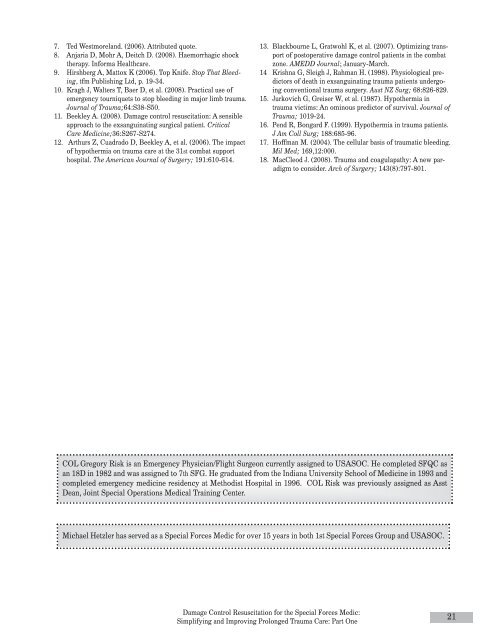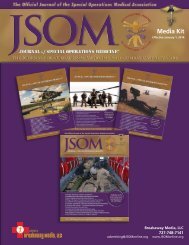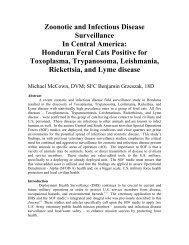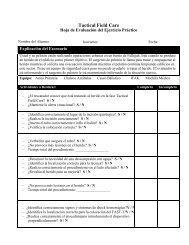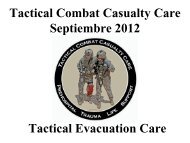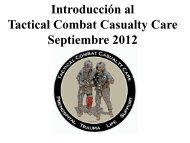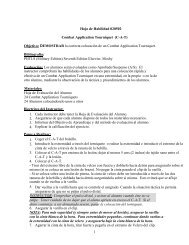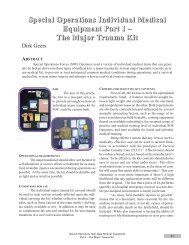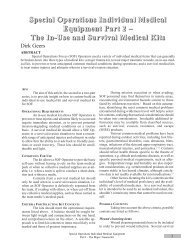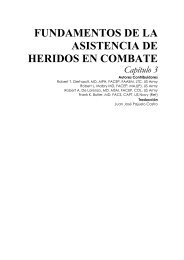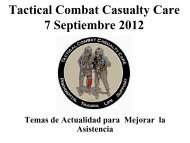Risk G. Hetzler M. Damage Control Resuscitation for the Special ...
Risk G. Hetzler M. Damage Control Resuscitation for the Special ...
Risk G. Hetzler M. Damage Control Resuscitation for the Special ...
You also want an ePaper? Increase the reach of your titles
YUMPU automatically turns print PDFs into web optimized ePapers that Google loves.
7. Ted Westmoreland. (2006). Attributed quote.<br />
8. Anjaria D, Mohr A, Deitch D. (2008). Haemorrhagic shock<br />
<strong>the</strong>rapy. In<strong>for</strong>ma Healthcare.<br />
9. Hirshberg A, Mattox K (2006). Top Knife. Stop That Bleeding,<br />
tfm Publishing Ltd, p. 19-34.<br />
10. Kragh J, Walters T, Baer D, et al. (2008). Practical use of<br />
emergency tourniquets to stop bleeding in major limb trauma.<br />
Journal of Trauma;64:S38-S50.<br />
11. Beekley A. (2008). <strong>Damage</strong> control resuscitation: A sensible<br />
approach to <strong>the</strong> exsanguinating surgical patient. Critical<br />
Care Medicine;36:S267-S274.<br />
12. Arthurs Z, Cuadrado D, Beekley A, et al. (2006). The impact<br />
of hypo<strong>the</strong>rmia on trauma care at <strong>the</strong> 31st combat support<br />
hospital. The American Journal of Surgery; 191:610-614.<br />
13. Blackbourne L, Gratwohl K, et al. (2007). Optimizing transport<br />
of postoperative damage control patients in <strong>the</strong> combat<br />
zone. AMEDD Journal; January-March.<br />
14 Krishna G, Sleigh J, Rahman H. (1998). Physiological predictors<br />
of death in exsanguinating trauma patients undergoing<br />
conventional trauma surgery. Aust NZ Surg; 68:826-829.<br />
15. Jurkovich G, Greiser W, et al. (1987). Hypo<strong>the</strong>rmia in<br />
trauma victims: An ominous predictor of survival. Journal of<br />
Trauma; 1019-24.<br />
16. Pend R, Bongard F. (1999). Hypo<strong>the</strong>rmia in trauma patients.<br />
J Am Coll Surg; 188:685-96.<br />
17. Hoffman M. (2004). The cellular basis of traumatic bleeding.<br />
Mil Med; 169,12:000.<br />
18. MacCleod J. (2008). Trauma and coagulapathy: A new paradigm<br />
to consider. Arch of Surgery; 143(8):797-801.<br />
COL Gregory <strong>Risk</strong> is an Emergency Physician/Flight Surgeon currently assigned to USASOC. He completed SFQC as<br />
an 18D in 1982 and was assigned to 7th SFG. He graduated from <strong>the</strong> Indiana University School of Medicine in 1993 and<br />
completed emergency medicine residency at Methodist Hospital in 1996. COL <strong>Risk</strong> was previously assigned as Asst<br />
Dean, Joint <strong>Special</strong> Operations Medical Training Center.<br />
Michael <strong>Hetzler</strong> has served as a <strong>Special</strong> Forces Medic <strong>for</strong> over 15 years in both 1st <strong>Special</strong> Forces Group and USASOC.<br />
<strong>Damage</strong> <strong>Control</strong> <strong>Resuscitation</strong> <strong>for</strong> <strong>the</strong> <strong>Special</strong> Forces Medic:<br />
Simplifying and Improving Prolonged Trauma Care: Part One<br />
21


